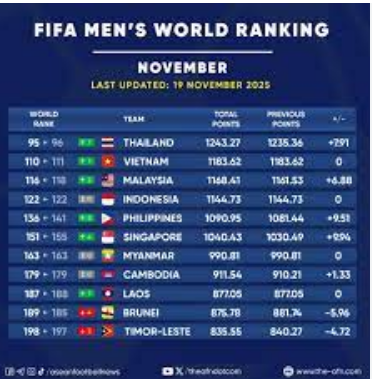Overview of the FIFA Men’s National Team Rankings
The FIFA Men’s National Team Rankings are a crucial element in the evaluation of national teams’ performance in international football. Established to provide a standardized measure of team strength, these rankings are instrumental for various stakeholders, including teams, fans, and sporting authorities. The rankings are updated periodically, reflecting the dynamic nature of football and allowing for real-time assessments of national teams in global standings.
Several criteria contribute to the calculation of the FIFA rankings, with match results being the primary factor. Victories, draws, and losses in international matches are scored and weighted according to the significance of the competition. For instance, matches played during prominent tournaments, such as the World Cup or continental championships, have a greater influence on rankings compared to friendly games. Additionally, the ranking algorithm considers the strength of the opposing team, which means that a win against a higher-ranked team has more value than a win over a lower-ranked one.
The impact of FIFA rankings extends beyond mere statistics; they play a vital role in qualifying teams for major international tournaments. The higher a team is positioned in the rankings, the greater its chances of being seeded in crucial competitions. This seeding can affect match draws and overall tournament progression, emphasizing the strategic importance of maintaining a favorable ranking. Regular updates to the FIFA rankings also keep national teams and their supporters informed about their competitive standing, creating an atmosphere of anticipation as updates are released. Overall, understanding the FIFA Men’s National Team Rankings provides essential insights into the football world, influencing decisions made on and off the pitch.
Key Changes and Surprising Movements in Rankings
The FIFA Men’s National Team Rankings, which highlight the global standings of national teams, have witnessed significant changes since the last update. Various national teams have experienced remarkable shifts, driven by recent performances in international competitions and friendlies. A notable upward movement can be observed in the rankings of several teams that secured impressive victories against higher-ranked opponents. For instance, Team A, previously ranked 15th, surged to 10th place after an exceptional run in the qualifiers, showcasing their development and competitive prowess.
On the contrary, certain teams have faced unexpected declines that have raised eyebrows among fans and analysts alike. Team B, once considered a powerhouse, dropped from the top ten to the 14th position following a string of disappointing results in major tournaments. The decline can be attributed to multiple factors, including injuries to key players and a struggle to adapt to new tactical systems. This drop in ranking has sparked discussions about the team’s future and the necessary adjustments to reclaim their status among the elite.
Moreover, surprising movements in the rankings are not solely confined to significant wins and losses. Factors such as the performance of other teams and the overall competitive landscape also play vital roles. For example, Team C’s unexpected rise to 7th place has captivated attention, particularly due to their strong showing in the Nations League. The reactions across social media platforms have been mixed, with some praising the team’s efforts and others questioning the sustainability of their recent achievements.
In summary, the latest updates in the FIFA rankings illustrate the dynamic nature of international football. The shifts in positions reflect both individual match outcomes and broader trends within competitive play, emphasizing that the landscape of global football is always evolving.
Impact of FIFA Rankings on Upcoming International Competitions
The FIFA Men’s National Team Rankings have significant implications for upcoming international competitions, particularly for events like the World Cup qualifiers and continental championships. The rankings serve as a guide for the seeding process, determining how teams are placed into various groups and associations during these tournaments. Higher-ranked national teams are often seeded in more favorable positions, which can lead to a perceived easier path through the competition.
In the context of the November 2025 rankings, nations positioned higher in the global standings may find themselves benefitting from advantageous matchups during the qualifiers. For instance, if a team is situated in a lower-ranked pot, they may face stronger opponents during group draws, impacting their chances of progression. Conversely, a well-ranked team could be grouped with slightly less competitive national teams, increasing their likelihood of advancing further in the tournament. This reality can shape not only preparation strategies but also the overall approach teams take in the qualifiers.
<pmoreover, a="" adds="" ahead="" aiming="" an="" and="" are="" as="" been="" bolster="" can="" competitions.="" confidence="" element="" enhance="" environments.="" every="" fifa="" focus="" for="" friendly="" game="" have="" high-stakes="" higher="" higher-ranking="" impacting="" important="" improve="" in="" intensifies,="" is="" leading="" likely="" matches="" national="" never="" of="" on="" outperform="" p="" particularly="" perception,="" place="" preparations="" pressure="" prestigious="" public="" qualification="" ranking="" ranking,="" rivals="" rounds,="" securing="" stakes="" standings="" strategic="" strategies.
Future Projections and Trends in International Football
The FIFA Men’s National Team Rankings provide a valuable insight into the current standing of national teams across the globe. However, these rankings also offer a glimpse into future trends and projections for international football. Based on the existing global standings, a few emerging patterns can be observed that may shape the landscape of the sport in the years to come.
Firstly, the rise of emerging footballing nations is a notable trend. Countries that have historically been considered underdogs are beginning to climb the rankings, showcasing the impact of investments in grassroots programs and youth development. Nations such as Qatar and Iceland have already demonstrated that with proper development structures in place, they can compete on a larger scale. This is likely to prompt a more competitive environment in international tournaments, challenging the dominance of established teams.
Additionally, as coaching strategies continue to evolve, there is a growing emphasis on tactical flexibility and player versatility. National teams are increasingly adopting modern training methodologies that prioritize skill development and tactical awareness. This shift in coaching dynamics can lead to better performances on the pitch, potentially altering the FIFA ranking scenario as teams adapt and refine their styles of play.
Moreover, the phenomenon of player transfers and dual nationality among footballers is also changing the dynamics. It allows national teams to bolster their squads with players who possess diverse skills and experiences, adding depth to their lineups. The ramifications of these changes may be reflected in the forthcoming FIFA Men’s National Team Rankings.
In conclusion, the interplay between emerging teams, evolving strategies, and impactful player movements will undoubtedly influence the future projections of international football, shaping how national teams perform and are ranked in the coming years.

